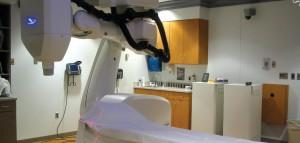A new type of radiosurgery might provide hope for patients suffering from one of the most deadly types of cancer.
Pancreatic cancer is among the most deadly forms of the disease. In the United States about 37,680 cases are diagnosed yearly and 34,290 people die of the illness, according to the National Cancer Institute. The main reason for this high death rate is that pancreatic cancer is very difficult to detect in its early stages, so by the time it is diagnosed the tumors have often spread extensively.
The results from a five-year study on the affect of the CyberKnife on pancreatic cancer treatment, released Monday, showed promising trends in the use of the instruments on treating recurring pancreatic cancer.
The study was led by Dr. Christopher Lominska, a resident in radiation medicine at the Lombardi Cancer Center.
“We found an acceptable safety profile for those receiving radiosurgery,” Lominska said in a press release.
The study specifically focused on cancer patients suffering from recurring tumors who had already been treated with chemotherapy and radiation. The findings were presented at the 50th Annual Meeting of the American Society for Therapeutic and Radiology Oncology in Boston on Sept. 21.
“We were able to safely treat them with more radiation using the CyberKnife,” Lominska said. “This might not have been possible using other radiation techniques.”
The CyberKnife is a product designed by the company Accuray, which delivers accurate, focused doses of radiation using a linear accelerator. From a patient’s perspective, the treatment is similar to getting a very long X-ray.
Lominska and his colleagues analyzed the records of 28 patients treated for pancreatic cancer between June 2002 and July 2007, and follow-up was available for 24 of the patients. Of the 24 patients, 20 had prior chemotherapy treatment.
The median survival time from the date of radiosurgery was found to be 5.85 months with follow-up, which is much longer than patients with extensive and recurring tumors are generally expected to live.
The CyberKnife is unique in its accuracy, allowing higher doses of radiation to more localized areas. The radiation administered for the standard treatment of chemotherapy can harm other parts of the body as well as the target. Treatment with the CyberKife is also attractive to many patients because a full course can be given in about five days, which is much shorter than the time required for standard chemotherapy.
The CyberKnife has been used at the Lombardi Center to treat several different types of cancer, and pancreatic was added to the list in 2004 after a new update allowed the machine to move with a patient’s breathing, making it accurate enough to use in close proximity to vital organs that could be harmed by extreme radiation.
The best chance of survival for pancreatic cancer comes with surgery, something the CyberKnife can also be used to facilitate.
Georgetown University Hospital pancreatic surgeon Dr. Patrick Jackson said the CyberKnife is very useful in shrinking tumors in arteries and veins in the pancreas before taking patients to the operating room.
The study is still in its early stages and the patient results are not conclusive. but Lominska said the preliminary trends look good.
“We’re not suggesting it’s a substitute for chemotherapy, rather, a possible addition in appropriately selected patients,” Lominska said.
“








